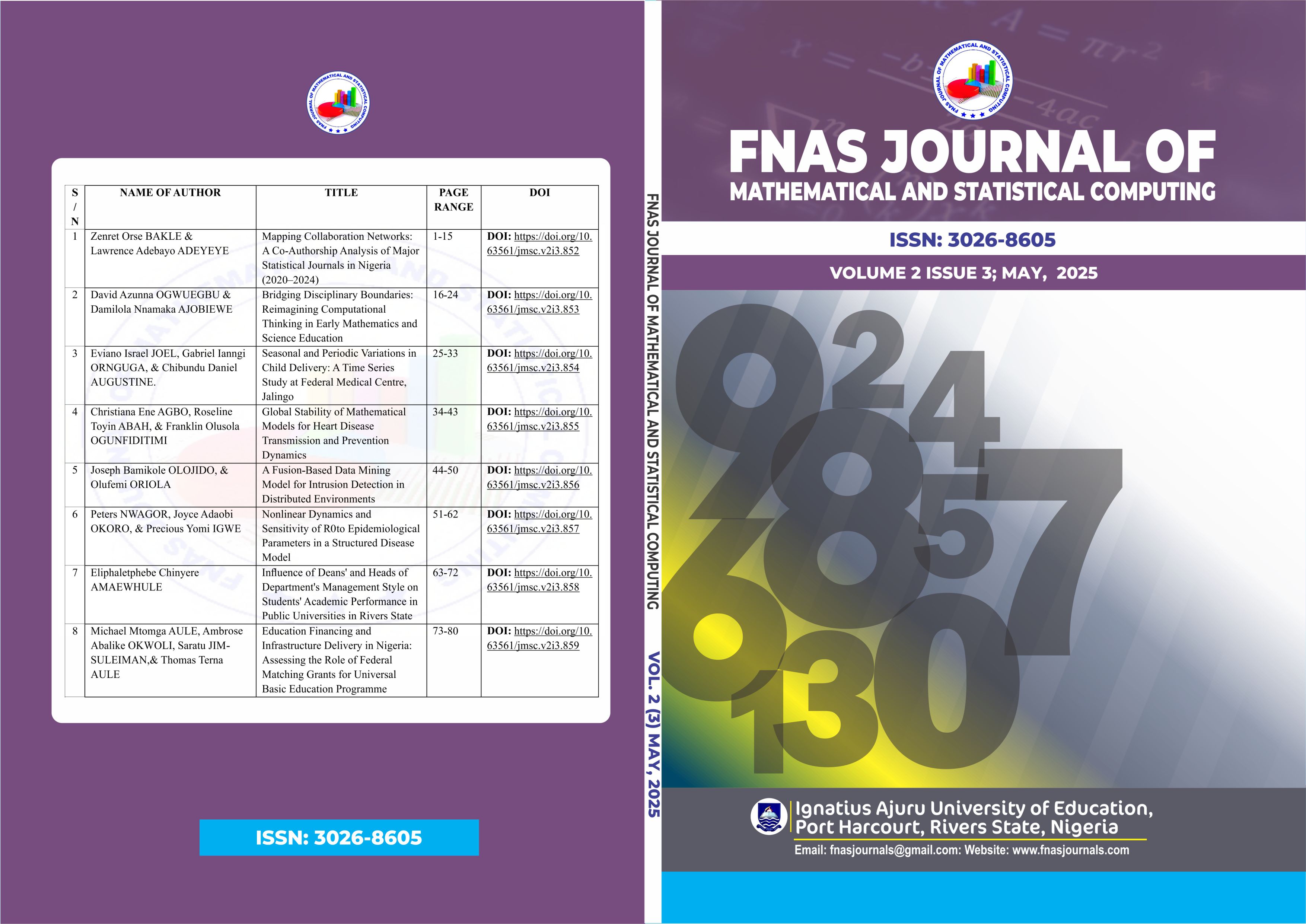Global Stability of Mathematical Models for Heart Disease Transmission and Prevention Dynamics
Main Article Content
Abstract
Heart disease remains a leading cause of global mortality, underscoring the urgent need for effective prevention and control strategies. This study analyses a compartmental mathematical model that capture the transmission and prevention dynamics of heart disease, incorporating both lifestyle-related and genetic risk factors. The model consists of six compartments—susceptible, two exposed classes (lifestyle and genetic), infected, treated, and recovered populations. Analytical methods are employed to establish the positivity and boundedness of solutions, determine the disease-free equilibrium (DFE), and compute the basic reproduction number ????0 using the next-generation matrix approach. Global stability of the DFE is proven via LaSalle’s Invariance Principle and an appropriately constructed Lyapunov function. Numerical simulations implemented in R programming validate the theoretical results, demonstrating that when ????0<1, the disease can be eradicated. Findings highlight the pivotal role of primary prevention, lifestyle modification, early detection, and treatment in reducing disease prevalence. This framework offers valuable insights for designing public health interventions and provides a basis for future model extensions incorporating demographic and spatial complexities.
Article Details
References
Agbo, C. E., Abah, R. T., & Ogunfiditimi, F. O. (2025). Mathematical modeling and stability analysis of the disease-free equilibrium of heart disease transmission and prevention dynamics. Faculty of Natural and Applied Sciences Journal of Mathematical Modeling and Numerical Simulation, 2(2), 165–171. https://fnasjournals.com/index.php/FNAS-JMNS/article/view/776
Agbo, C., Abah, R., & Abdullahi, A. M. (2024). A mathematical modeling on the stability analysis of heart disease dynamics: Mathematical modeling on the stability analysis of heart disease. Journal of Institutional Research, Big Data Analytics and Innovation, 1(1). https://universityjournals.com.ng/index.php/jirbdai/article/view/54/24
Alastruey, J., Parker, K., Peiro, J., Byrd, S., & Sherwin, S. (2007). Modelling the circle of Willis to assess the effects of anatomical variations and occlusions on cerebral flows. Journal of Biomechanics, 40(8), 1794–1805. https://doi.org/10.1016/j.jbiomech.2006.07.008 DOI: https://doi.org/10.1016/j.jbiomech.2006.07.008
Alsulami, R., Al Matrafi, A., Almohammadi, N., Alosaimi, H., & Batarfi, H. A. (2024). Global stability analysis of the mathematical model for malaria transmission between vector and host population. American Journal of Computational Mathematics, 14, 275–289. https://doi.org/10.4236/ajcm.2024.142012 DOI: https://doi.org/10.4236/ajcm.2024.142012
Batzel, J. J., Kappel, F., Schneditz, D., & Tran, H. T. (2007). Cardiovascular and respiratory systems: Modeling, analysis, and control. Society for Industrial and Applied Mathematics. https://epubs.siam.org/doi/pdf/10.1137/1.9780898717457.fm DOI: https://doi.org/10.1137/1.9780898717457
Cai, L., Wang, R., & Zhang, D. (2023). Cardiac disease modeling with engineered heart tissue. In M. H. Kuehn & W. Zhu (Eds.), Human iPSC-derived disease models for drug discovery (Vol. 281). Springer. https://doi.org/10.1007/164_2023_681 DOI: https://doi.org/10.1007/164_2023_681
Cardoso, L. C., Dos Santos, J. P. C., Camargo, R. F., & Dos Santos, F. L. P. (2021). Global stability analysis of a fractional differential system in hepatitis B. Chaos, Solitons & Fractals, 143, 110619. https://doi.org/10.1016/j.chaos.2020.110619 DOI: https://doi.org/10.1016/j.chaos.2020.110619
Jibril, L., & Odetunde, O. (2020). Mathematical modeling and optimal control analysis on sedentary behavior and physical activity in relation to cardiovascular disease (CVD). Biomedical Science and Engineering. https://doi.org/10.11648/j.bsi DOI: https://doi.org/10.11648/j.bsi.20200504.13
Kifle, Z. S., & Obsu, L. L. (2022). Mathematical modeling for COVID-19 transmission dynamics: A case study in Ethiopia. Results in Physics, 34, 105191. https://doi.org/10.1016/j.rinp.2022.105191 DOI: https://doi.org/10.1016/j.rinp.2022.105191
Masoumnezhad, M., Shateyi, S., Rajabi, M., Dorofeev, A., Kargar, N. S., Nik, H. S., & Chapnevis, A. (2020). An approach for the global stability of mathematical model of an infectious disease. Symmetry, 12(11), 1778. https://doi.org/10.3390/sym12111778 DOI: https://doi.org/10.3390/sym12111778
McBryde, E. S., Meehan, M. T., Doan, T. N., Ragonnet, R., Marais, B. J., Guernier, V., & Trauer, J. M. (2017). The risk of global epidemic replacement with drug-resistant Mycobacterium tuberculosis strains. International Journal of Infectious Diseases, 56, 14–20. https://doi.org/10.1016/j.ijid.2017.01.031 DOI: https://doi.org/10.1016/j.ijid.2017.01.031
National Heart, Lung, and Blood Institute. (2020). What is heart disease? https://www.nhlbi.nih.gov/health-topics/heart-disease
Oladipupo, S. J., Edogbanya, H. O., Emmanuel, J., & Olukanni, S. E. (2023). Stability analysis of COVID-19 model with quarantine. International Journal of Mathematical Sciences and Computing, 9(3), 26–45. https://doi.org/10.5815/ijmsc.2023.03.03 DOI: https://doi.org/10.5815/ijmsc.2023.03.03
Ortiz-Rangel, E., Guerrero-Ramírez, G. V., García-Beltrán, C. D., Guerrero-Lara, M., Adam-Medina, M., Astorga-Zaragoza, C. M., Reyes-Reyes, J., & Posada-Gómez, R. (2022). Dynamic modeling and simulation of the human cardiovascular system with PDA. Biomedical Signal Processing and Control, 71, 103151. https://doi.org/10.1016/j.bspc.2021.103151 DOI: https://doi.org/10.1016/j.bspc.2021.103151
Rosalia, L., Ozturk, C., Van Story, D., Horvath, M. A., & Roche, E. T. (2021). Object-oriented lumped-parameter modeling of the cardiovascular system for physiological and pathophysiological conditions. Advanced Theory and Simulations, 4, 2000216. https://doi.org/10.1002/adts.202000216 DOI: https://doi.org/10.1002/adts.202000216
Sadki, M., Harroudi, S., & Allali, K. (2023). Local and global stability of an HCV viral dynamics model with two routes of infection and adaptive immunity. Computer Methods in Biomechanics and Biomedical Engineering, 27(11), 1510–1537. https://doi.org/10.1080/10255842.2023.2245941 DOI: https://doi.org/10.1080/10255842.2023.2245941
Saidi, O., O’Flaherty, M., Zoghlami, N., Malouche, D., Capewell, S., Critchley, J. A., & Guzman-Castillo, M. (2019). Comparing strategies to prevent stroke and ischemic heart disease in the Tunisian population: this article as:
Agbo, C. E., Abah, R. T., & Ogunfiditimi, F. O. (2025). Global stability analysis of the mathematical modelling for heart
disease transmission and prevention dynamics. FNAS Journal of Mathematical and Statistical Computing, 2(3),
34-43.
Markov modeling approach using a comprehensive sensitivity analysis algorithm. Computational and Mathematical Methods in Medicine, 2019, 2123079. https://doi.org/10.1155/2019/2123079 DOI: https://doi.org/10.1155/2019/2123079
Simaan, M. A. (2009). Rotary heart assist devices. In Springer handbook of automation (pp. 1409–1422). Springer. https://doi.org/10.1007/978-3-540-78831-7_67 DOI: https://doi.org/10.1007/978-3-540-78831-7_79
World Health Organization. (2021, October 11). Cardiovascular diseases (CVDs). https://www.who.int/news-room/fact-sheets/detail/cardiovascular-diseases-(cvds)
Yang, Y., Tang, S., Ren, X., Zhao, H., & Guo, C. (2016). Global stability and optimal control for a tuberculosis model with vaccination and treatment. Discrete and Continuous Dynamical Systems - Series B, 21(3), 1009–1022. http://dx.doi.org/10.3934/dcdsb.2016.21.1009 DOI: https://doi.org/10.3934/dcdsb.2016.21.1009

